I had a pattern I’d never used before, which I bought because it had a tank top (or “shell” as my Mum calls them) which uses bias bands as facings. It is McCall’s 3610.
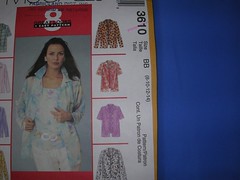
When I took the pattern pieces out, I measured the side seams and compared those measurements with shirts and tops I already had. I decided to take the pattern up in the body by two inches. I am quite short-waisted so I often have to do this with patterns. I fold the paper pattern along the line indicated for taking up and then fold it again along the dotted line for the maximum adjustment. You can see the fold better in the photo following this one.
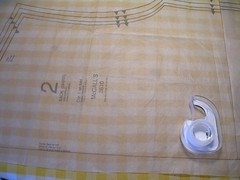
When I had all the pattern pieces out of the envelope, ironed and adjusted, I started laying them out on the fabric (I had about 2.5 meters of fairly narrow fabric). Because the top front and back pieces were both cut on a fold, I couldn’t get the top AND the shirt out of the fabric the way I tried to initially. I unpinned the pieces and had another look at it. I measured how much fabric I needed to get the top out of one end of the length of fabric and cut that piece off from the rest. Then I folded each selvage into the middle so I had two folds and pinned the front and back pieces of the top to the fabric. That is a line of selvage in the middle of the two pieces in the next photo.
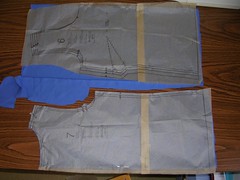
In this way, I managed to get the shirt cut out too, once I folded the remainder of the fabric back into its selvages-together/fold-on-one-side configuration. I ironed the interfacing to the collar (both sides) and front facings for the shirt. Then I pinned together as many pieces in one go as I could and started sewing.
In the next photo, I am pinning the sleeve to the shirt. I have it here to illustrate how I put a pin in the ironing board cover and gently pull the armscye out so I can eliminate wrinkles. It also shows how this fabric has already started to fray, a constant complaint of most polyesters.
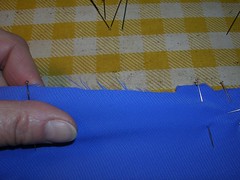
This blog entry is mostly about the bias strips used instead of two inch wide facings, on the top. I have no idea why the colour in the next photo is so off but anyway, I have started to pin the bias strip (it is folded in half lengthwise) around the neck edge of the top. You can see that the strip is longer than the neck edge and so the bias strip will have to be eased into the neck with lots of pins.
Which reminds me that I changed the sewing machine needle for this project to the finest, thinnest needle I had. It has the numbers 55/7 on it - usually I sew with a 80/12 needle. Polyester also snags very easily so I made sure the needle was brand new and didn’t have any flaw on the point AND I am removing every pin as I sew, to make sure the needle never comes in contact with metal.
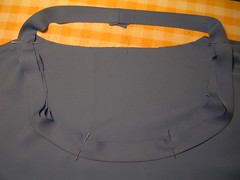
Here, I am sewing around the armhole and you can see that the bias strip has more fabric in it than the armhole edge, in that it is buckling up.
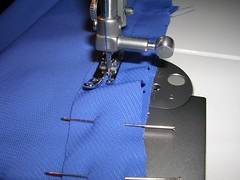
Now you can see that as I sew, I am gently pulling the armhole so that the bias strip fits. I have my right hand on the camera for the photo, but usually it is gently pulling the material behind the needle. It doesn’t matter which hand goes in front or behind - just don’t get your fingers caught under the needle! I have heard of people who have done that but in 30 years of sewing, I have never sewed my finger to the garment. I have certainly stabbed myself with pins and even cut myself with the scissors but I haven’t been run through by the machine needle.
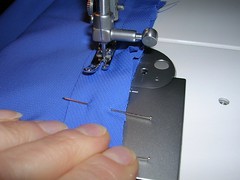
At one point, I left the room and when I got back, the dog had decided under the ironing board was a good place for a nap. Not wanting to disturb him, I worked around the body.
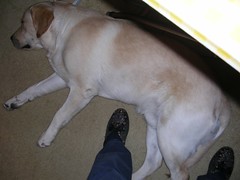
After sewing the bias strip facings on, they have to be trimmed.
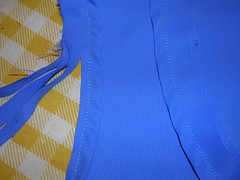
Then you have to press them, starting with pressing the facing away from the top.
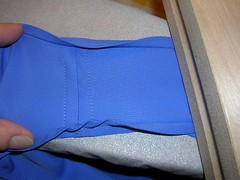
Then you press the facing in a fold, over the raw (and now fraying) edge of the armhole or neck edge.
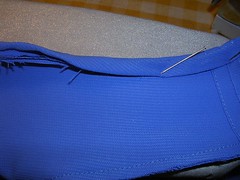
Finally, you sew the facing down, from the wrong side of the garment to make sure you catch the edge of the facing, using a zipper foot to get close to the edge. You can also see that I have done a modified flat fell on the shoulder seam for the top.
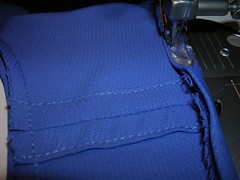
3 comments:
Yes,,, dog's gotta have a snooze!!
dog is adorable. great instruction as always!
Thanks Lois and Miriam!
For more on the dog, you can go to http://puppywalking.blogspot.com if you like.
Post a Comment